TL;DR
- Open source CRMs cut costs and enable deep customization, scalability, and community-backed support for nonprofits.
- Trade-offs: need technical skills, DIY maintenance, inconsistent updates, and harder integrations.
- Top 2025 picks: Flatlogic, CiviCRM, SuiteCRM, Odoo, Dolibarr, EspoCRM.
- Choose based on ease of use, customization, integrations, community activity, and total implementation cost.
Fact Box
- 67% of nonprofits now use a CRM. Source
- The article names six open source CRM picks for 2025: Flatlogic, CiviCRM, SuiteCRM, Odoo, Dolibarr, EspoCRM.
- Flatlogic claims its AI can create an app within minutes.
- Open source CRMs are typically free to use with no recurring license fees.
- Drawbacks cited: need technical expertise, limited support, inconsistent updates, and integration difficulty.
Are you working in a nonprofit and don’t know which CRM to use? Read on as we dive into the best open source CRMs for nonprofits in 2025.
Do nonprofits need to use CRMs too? What makes a CRM suitable for nonprofit organizations? Which CRMs are the best for nonprofits? Should they be using open source CRMs?
Businesses and nonprofits, despite the differences in processes and aims, have the same intermediary goal of satisfying stakeholders. So it’s no surprise that 67% of nonprofits now use a CRM
From managing donations and donors to organizing events and connecting with volunteers, CRMs can streamline processes and foster stronger relationships. However, most CRMs specifically cater to for-profit organizations.
So in this article, we’ll dive into why open source CRMs are the best for nonprofit missions. And to make it easy for you, we’ll list down our top picks for the best open source CRMs for nonprofits in 2025.
What is a CRM?
A CRM, short for Customer Relationship Management, is software designed to help businesses and organizations maintain their relationships with customers and other stakeholders.
It’s through such software that organizations interact and track said interactions with both current and even potential customers. By helping them track things like sales calls, consumer inquiries, customer service interactions, and even marketing emails, they can better analyze their target audience’s behavior and adjust their strategies accordingly.
A nonprofit CRM is simply a CRM specifically catered to nonprofit causes (like tracking donations), as most CRMs are typically made for businesses looking to make a profit. However, there are also several CRMs that can cater to both for-profit and nonprofit organizations
Many CRMs are available in the market right now, which can make it confusing and overwhelming when choosing the right one for your organization. This is why we’re listing creating a list of the best open source CRMs for nonprofits in 2025.
Why Nonprofits Need CRM Software
Nonprofits, charities, advocacy groups, and other similar organizations often juggle numerous responsibilities and have multiple moving parts in their programs and operations. This is all the more true the bigger the organization is. There can be countless factors to keep track of. 
Fundraising, volunteer coordination, marketing, program management, recording donations, and tracking grant applications-all these operations and more can be greatly simplified with the proper nonprofit CRM.
After all, whether it’s a nonprofit or a business, their success relies on how well they satisfy people’s needs!
By consolidating and organizing data about client interactions into a centralized, user-friendly platform, a CRM can enable organizations to:
- Enhance Donor Engagement
CRMs make it easy to interact with donors and other people. They allow you to schedule, send, and manage SMS, calls, and email communications with donors, stakeholders, and benefactors in one platform.
They also allow you to record and analyze donation histories and amounts given, segment audiences, and personalize communication. This further allows you to understand your donors better and know what makes them keep giving. After all, donations are what keep nonprofits alive!
Such data can of course also be used to determine how to get even more donors.
- Streamline Operations
We all know that manually conducting administrative tasks is a large time and energy sink. CRMs can do a large bulk of this grunt work for you, freeing up your staff for other tasks and boosting your overall efficiency.
- Improved Transparency
Having your finances and donations mixed up and untracked can frustrate your donors and shareholders-after all, they want to know their money is getting put to good use! CRMs can not only track all this information, but they can also generate detailed reports to showcase the organization’s impact on its target communities and benefactors. Show these reports to donors and stakeholders, which can further build trust-and therefore keep donations coming in.
Benefits of Open Source CRMs for Nonprofits
However, here’s the problem: most CRMs have features and systems that are specifically catered to for-profit businesses-nonprofits and NGOs are an afterthought, And as we know, nonprofits can often operate in vastly different ways.
Here’s where open source CRMs come in.
When a piece of software is open source, this means that the source code of such programs can be modified to fit the specific needs of an organization. This makes open source ones a great nonprofit CRM as they offer flexible stakeholder management solutions for groups of all sizes.
Here’s why nonprofits should probably prioritize looking for open source CRMs:
- Cost-Effectiveness
Open source CRMs are typically free to use with no recurring license fees-or at least generally cost very little compared to commercial and mainstream CRMs.
This is great for nonprofits whose funds are typically tighter compared to businesses and need to be even wiser with their spending. After all, nonprofits will want to allocate most of their funds toward their missions and programs!
- Customization
Not only do nonprofits differ from businesses, but there can also be vast differences between the inner workings and operations of one nonprofit organization to another. For example, some nonprofits may rely more on government grants rather than donations.
Open source solutions allow full access to the source code of the software, enabling organizations to edit and modify or even completely mold the software altogether according to their exact needs.
- Scalability
And part of being extremely customizable is their ability to scale. As nonprofits grow (which they likely will once they use CRMs), open source CRMs can be further modified to scale and be able to accommodate even larger sets of data and other functionality requirements.
- Community Support
The communities around open source software often have vibrant, supportive communities of developers who regularly contribute updates, plugins, and troubleshooting advice to users. And they do all of this, typically speaking, for free!
- Transparency
Part and parcel of the ethos of open source projects is the spirit of transparency. This means that users can rest assured that they will have full visibility into how their data is handled by the software and its developers.
Cons of Open Source CRMs for Nonprofits
While there are several clear and worthwhile benefits to open source CRMs, they also have certain limitations:
- In-house Expertise Requirements
When using an open source CRM, you’re largely on your own. This is especially considering that open source CRMs are more complex to install and use. You’ll need coders and IT experts who know how to modify the source code of these programs to your specific needs. And so the price of going for free software is the additional need for labor.
If you don’t have any technical programming and CRM know-how in your organization, you may need to hire an external consultant or expert. This, of course, can also offset the money you saved from opting for a free open source CRM.
On the other hand, makers of propriety or commercial CRMs will promise to make their programs as easy as possible to use, even without much experience or technical knowledge. (After all, they want to sell you their programs!)
- Maintenance and Support
In a similar vein, you’re also on your own if something goes wrong with the program (or if you make a mistake when using/modifying it).
While yes, there will be people in that open source CRM’s community who might be willing to help you, there’s still a chance that no one at that specific time is available or may know how to help you.
Again, this is unlike using proprietary CRM software which often has dedicated customer service experts who are there to help users with problems.
- Inconsistent Updates
Broadly speaking, updates for open source software aren’t the most frequent or consistent. This can unfortunately lead to gaps in functionality (like integrating with newer apps, as to be discussed below) or even increased security risks.
So while open source developers and communities always promote transparency, it’s still a good idea to always do your due diligence. Since nonprofits often handle sensitive data about their stakeholders, consider using VPNs whenever you use a CRM. Click on this link to read more about VPNs.
After all, everything in open source communities is done out of goodwill and not profit. (And, as you may know, if you work in a charity or nonprofit, goodwill is not, unfortunately, always the most reliable.)
- Integration Difficulty
Open source software typically lacks the robust pre-programmed connectors that allow them to be used right out of the box with other software like Content Management Systems (CMS).
As such, you’ll also need to figure out how to integrate them into the other programs you use in your organization.
Here’s a table for a quick reference on the pros and cons of open source CRMs.
| Pros | Cons |
| Free or costs very little | Requires technical knowledge to install, modify, and use |
| Customizability | Lack of dedicated support for maintenance |
| Scalability | Inconsistent Updates |
| Free community support | Difficulty with integrating other programs |
| Transparency |
There are definitely limitations to using open source CRMs. However, the benefits can still outweigh them if you think you can manageably deal with the potential struggles!
If so and you’re dedicated to going with an open source nonprofit CRM, check out our list below.
Top Open Source CRMs for Nonprofits in 2025
Here are the leading open source CRMs that nonprofits should consider using this year. We’ll also list each CRM’s key features, as well as their pros and cons.
1. Flatlogic
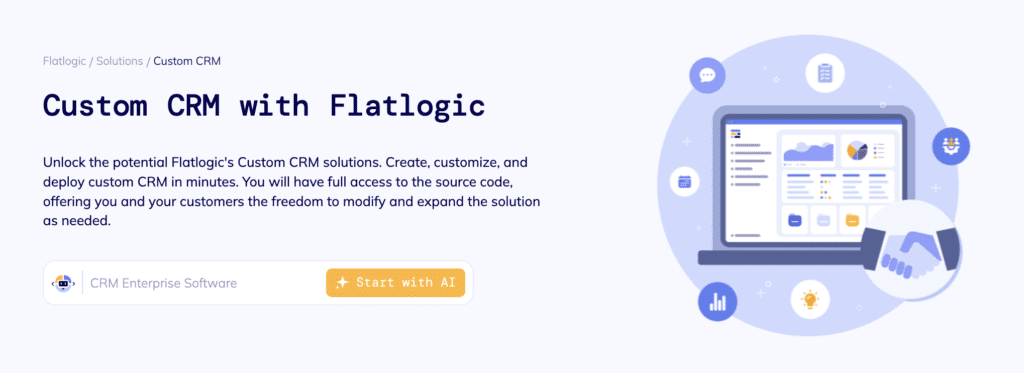
Source: flatlogic
Flatlogic is AI-powered app builder for businesses. With the help of AI, businesses can create CRMs, ERPs, or SaaS-or apps that combine them all-without deep coding knowledge or extensive development time. An app can be creatine within minutes, and its AI features allow for near-limitless customizability.
Key Features:
- Custom AI-powered app builder
- Automated analytics
- Pre-built templates
- One-click hosting
- Install any feature with AI
Pros: By talking to flatlogic’s AI software engineer, you can, at least theoretically speaking, create an app with virtually any feature you may need (registration, donor tracking, event management, etc.). This allows for near-limitless customizabiltiy compared to any other open source CRM platform.
Because of this, flatlogic is perfect for organizations who have need specific app customizations but have little to no coding expertise.
With their pre-built templates, you can also get an app created and customized within a day. By comparison, custom app creation will likely take you weeks of development time. Additionally, you also own the intellectual property rights to whatever app you create with flatlogic’s code.
Cons: However, learning how to talk to its AI software engineer may be tricky at first. It may not completely understand what you mean when you explain the kind of app you need. In some ways, it’s easier than talking to a person, but in other ways, it’s more difficult.
Unlike many other open source CRMs, flatlogic requires a subscription plan.
2. CiviCRM
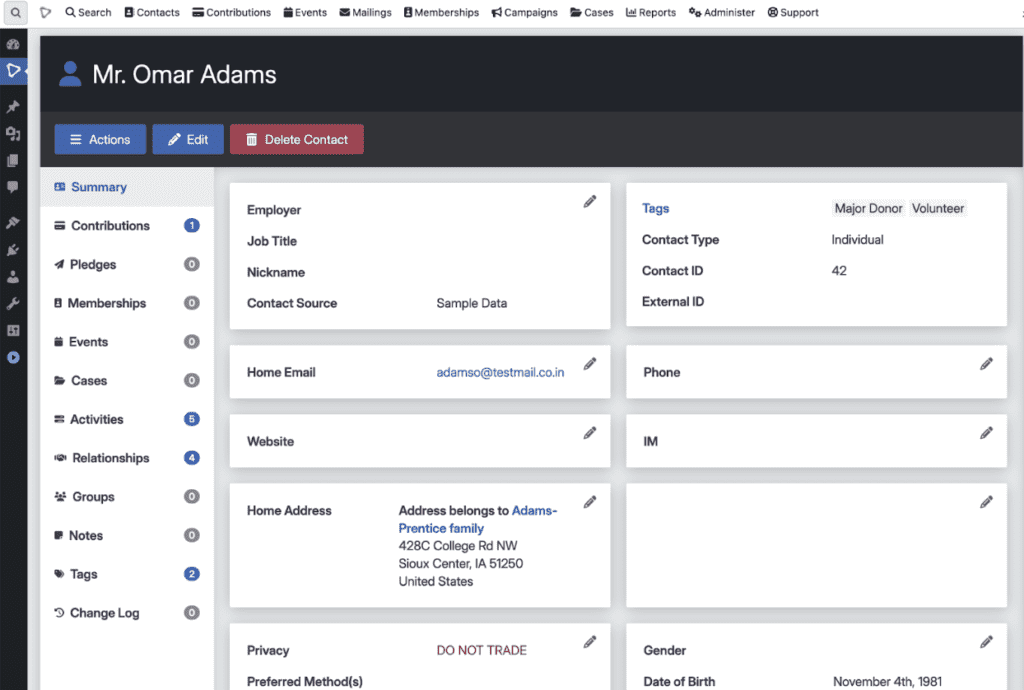
Source: CiviCRM
Arguably the most popular open source nonprofit CRM, CiviCRM is specifically made for nonprofits, charities, and civic-sector organizations. As such, it has been a staple in the nonprofit space for years.
Key Features:
- Fundraising and donation tracking
- Member registration
- Event management and registration
- Volunteer management
- Email marketing integration
- Available in multiple languages
Pros: CiviCRM’s features cater directly and specifically to nonprofit needs such as donor relationships and event coordination-and offer great customizability on those nonprofit-focused features. If this is your top priority, consider CiviCRM.
On the other hand, the other CRMs on this list try to “strike a balance” so to speak, and aim to make themselves usable by both nonprofits and businesses. CiviCRM also integrates seamlessly with other platforms like WordPress, Joomla, and Drupal.
This makes it perfect for larger organizations that may also use those programs.
Cons: CiviCRM’s high customizability means that setting it up or modifying it will need extensive technical expertise. You may require assistance from an external developer if you don’t have one in-house.
3. SuiteCRM
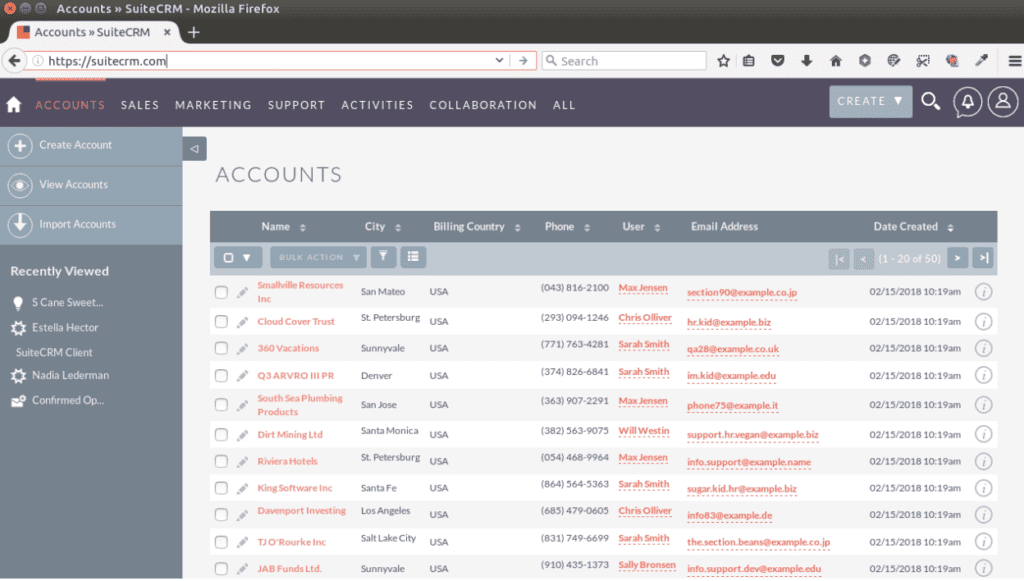
Source: SuiteCRM
SuiteCRM is a fork of the Community Edition of SugarCRM, a propriety CRM, with additional modules. SuiteCRM is relatively easier to use out of the box than many other open source CRMs.
Key Features:
- Reporting and analytics
- Workflow automation
- Email campaign management
- Customizable dashboards
- Mobile-friendly interface
Pros: SuiteCRM’s versatility and ease of use make it ideal for nonprofits that need an all-in-one solution right out of the box. Its automation features can also save staff time by streamlining repetitive admin tasks.
This may make it preferable for smaller-sized NGOs and nonprofits compared to CiviCRM, as it generally requires less knowledge on initial use.
Challenges: Although SuiteCRM is highly user-friendly, installing or modifying its advanced features does have a rather steep learning curve for new users.
4. Odoo
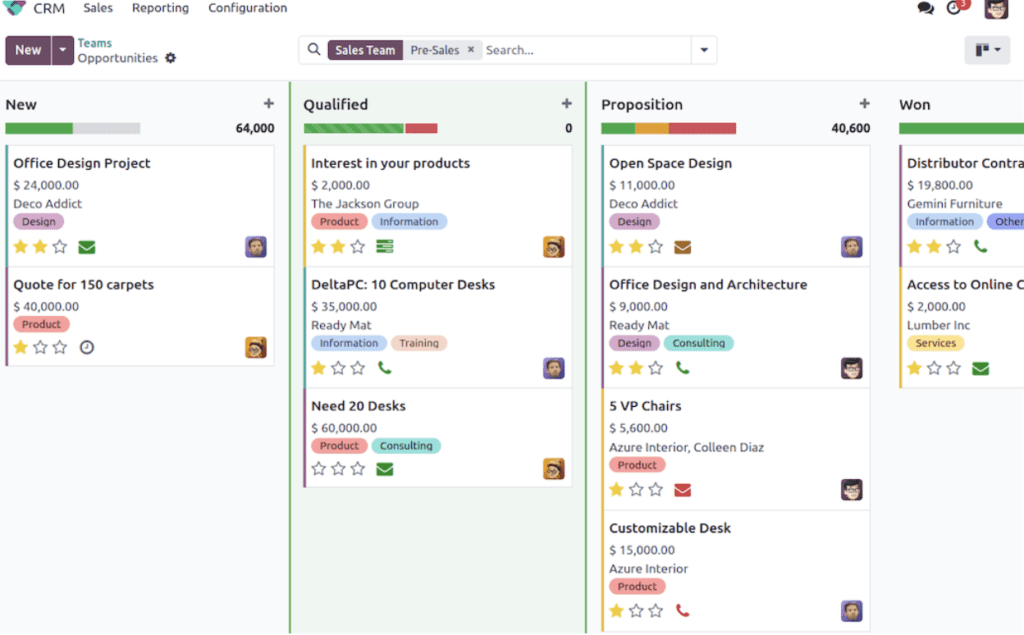
Source: Odoo
Odoo is a modular open source software suite that includes not just CRM capabilities, but also ERP (Enterprise Resource Planning) features. This 2-in-1 combination allows for unparalleled flexibility and a robust set of features.
Key Features:
- Lead management and scoring
- Calendar and task integration
- Multi-channel communication tracking
- Budgeting and accounting modules
- E-commerce integration
Pros: There are a lot of modules in Odoo, but you can choose to use only the ones you need. This modular structure means that nonprofit users can build a solution tailored to their specific needs. Like CiviCRM, it also integrates well with many other common business software.
Its ERP features include inventory management, accounting, and sales (among others). The fact that Odoo also includes ERP functionalities makes it the top choice for nonprofits who also rely on profit generation for their funding.
Challenges: The free version, known as Odoo Community has relatively limited features compared to its paid version, Odoo Enterprise.
5. Dolibarr
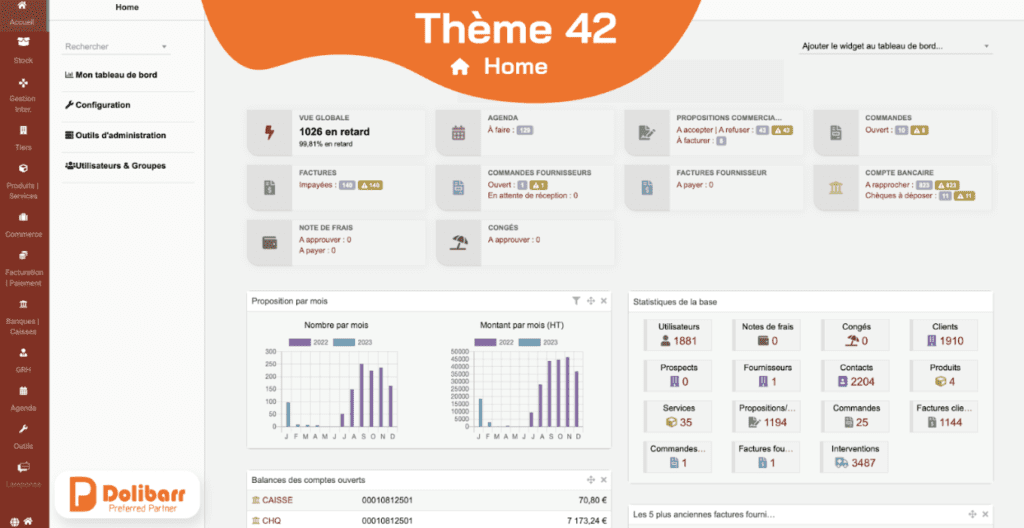
Source: Dolibarr
Dolibarr also markets itself as an all-in-one ERP and CRM solution. However, compared to Odoo, it’s relatively more straightforward and lightweight, making it somewhat easier to use for non-trained staff. However, it remains customizable in many ways due to having an open API.
Key Features:
- Donor and member management
- Project and task management
- Financial tracking and invoicing
- Integration with third-party tools
- Open API for custom development
Pros: Dolibarr is simple and user-friendly, making it accessible for smaller nonprofits that don’t have dedicated IT personnel.
However, to make the most out of its customizability, you’ll still need experts who can tinker with its API for custom developments and integrations.
Its ERP functionalities also make it suitable for small nonprofits who conduct business on the side for funding.
Challenges: Dolibarr focuses on the most common and basic CRM and ERP features, so they lack some advanced features that others on this list have.
6. EspoCRM
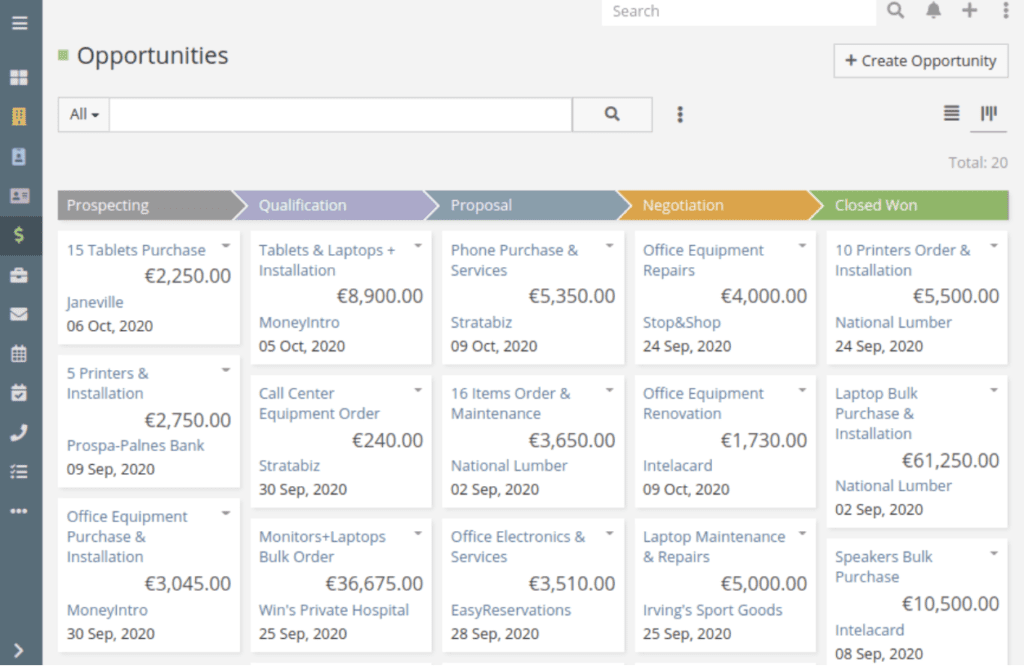
Source: EspoCRM
EspoCRM is a free and lightweight yet powerful CRM that offers a balance of simplicity and customizability. Additional modules can be installed for a fee if users need more advanced features
Key Features:
- Contact and account management
- Email and phone call logging
- Robust customer tracking
- Kanban view for data visualization
- REST API for integrations
Pros: EspoCRM’s sleek and user-friendly interface reduces the learning curve for staff (and is also our personal favorite).
It’s as customizable as it gets, allowing you to self-host the CRM for added security. For nonprofits with unique workflows, its top-tier customizability can be a game-changer.
Cons: Much of its flexibility and customizability lies in its paid modules.
Factors to Consider When Choosing an Open Source CRM
Selecting the right CRM for your nonprofit involves evaluating several factors:
- Ease of Use
Ensure the CRM is intuitive for your team, its preferences, and technical and programming knowledge.
- Customization and Scalability
Look for software that can be tailored to your organization’s workflows and size. Some CRMs are better suited for smaller nonprofits, while bigger organizations may need something more robust.
- Integration Capabilities
Check whether the CRM integrates with other programs you use, such as CMS software, e-commerce programs, or payment processors.
- Community Support
Opt for CRMs with active communities that have developers who regularly contribute and help users. This makes it more likely for the CRM to be regularly updated or offer troubleshooting assistance.
- Cost of Implementation
While the software may be free, make sure to budget for additional IT expenses, paid modules, and maintenance too.
How to Get Started with Open Source CRMs
Want to try out open source CRMs? Here’s a step-by-step guide to integrating one into your organization.
- Assess Your Needs
Firstly, identify the features and functionality your nonprofit requires based on your workflows and processes.
- Research Options
Compare CRMs based on their suitability for your mission and budget. Try asking other organizations in your industry if they have a CRM they would recommend as well.
- Test Demos
Many open source CRMs offer free trials or demos. As with open source CRMs, many of them are completely free, so there is no cost to experimenting.
- Plan Implementation
Once you’ve decided on a CRM, define a timeline for deployment, data migration, and staff training.
- Consult the Community for Support
Open source CRMs often have their own user forums. Check these out as they typically include documents for guidance, including answers and solutions to common problems.
- Monitor and Optimize
You’ll likely realize how you want to modify and customize the CRM as you go along. So regularly review your CRM usage and make adjustments to maximize its usefulness
Conclusion
Open source CRMs are a powerful, cost-effective way for nonprofits to be both more efficient and more effective at conducting their missions.
While they may need additional labor to customize them according to your needs, the precision open source CRMs offer is unparalleled when it comes to creating the perfect software for your organization.
Comments